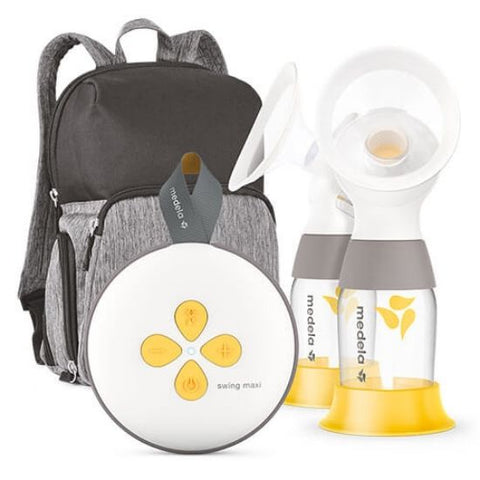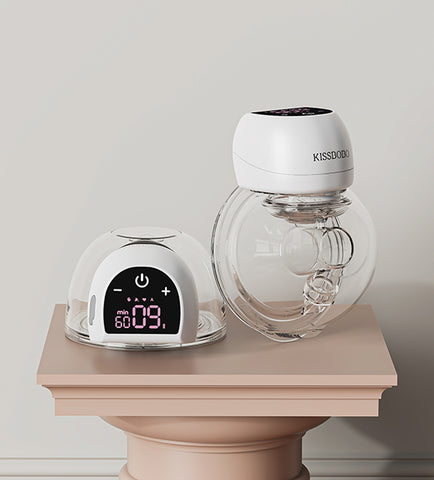As a new mom, you've likely realized that feeding a newborn is a wonderful yet challenging experience. Choosing the right breast pump can not only help you manage breastfeeding better but also ensure your baby receives adequate nutrition. However, with the plethora of types and brands of breast pumps on the market, you might feel confused and overwhelmed.
This article will delve into the three main types of breast pumps—electric, battery-operated, and manual—analyze their advantages and disadvantages, and provide practical advice to help you make an informed choice based on your lifestyle and needs. We will also specifically recommend products suitable as primary and backup breast pumps, ensuring you can breastfeed smoothly in any situation. Through this article, you will learn how to choose a breast pump that is both efficient and comfortable, making your breastfeeding journey smoother and more enjoyable.
Introduction to Types of Breast Pumps
Traditional Electric Breast Pumps

Electric breast pumps, often the first choice for many moms, usually require a power connection. Thus, they typically offer stronger suction and more stable performance than wearable breast pumps. Here are some core advantages and disadvantages of traditional electric breast pumps:
Advantages:
Powerful Suction: Connected directly to a power source, traditional breast pumps provide consistent and strong suction, crucial for moms who need to express a significant amount of breast milk frequently.
Stability: Unlike battery-operated wearable pumps, traditional breast pumps maintain consistent suction, ensuring continuous and efficient pumping.
Versatility: Many traditional breast pumps come with various adjustable modes and suction levels, allowing moms to customize their pumping experience to optimize comfort and efficiency.
Disadvantages:
Limited Mobility: Moms are confined to one spot during pumping sessions and can only move freely once pumping is complete.
Portability Issues: Compared to wearable pumps, traditional breast pumps are less convenient for use on the go, especially in places without convenient power access.
Moms who choose traditional breast pumps typically prioritize efficiency and stability. This type is ideal for those who do not need to move around frequently and primarily nurse at home or a fixed location. When considering a traditional breast pump, evaluate your lifestyle and breastfeeding needs to ensure the product meets your requirements.
Wearable Breast Pumps

Wearable breast pumps are favored by many modern moms for their outstanding portability and flexibility. These pumps usually have built-in batteries and can be used without an external power source, allowing moms to pump while engaging in daily activities. Here are the advantages and disadvantages of wearable breast pumps:
Advantages:
Extreme Portability: The design of wearable pumps allows moms to use them without being tethered to a power source, greatly enhancing mobility and flexibility.
Discreet and Comfortable: Typically, wearable pumps can be placed inside a bra without external tubes or wires, offering discretion and increasing comfort during use.
Multitasking Capability: Wearable pumps enable moms to pump while taking care of other tasks, such as looking after the baby, working, or doing household chores, improving overall efficiency.
Disadvantages:
Battery Life Issues: Although modern wearable pumps have improved battery technology, battery life can still be a limitation, especially with frequent use.
Higher Cost: Due to their technological and design complexity, wearable pumps are generally more expensive than traditional models.
Moms who opt for wearable breast pumps usually seek maximum freedom and convenience during breastfeeding. This type of pump is ideal for those who often need to go out or wish to pump while working or engaging in other daily activities. When purchasing, consider the pump’s battery life and suction settings to ensure it meets your needs.
Manual Breast Pumps

Manual breast pumps rely on the user's effort and do not need electricity, making them more reliable and convenient in some situations than electric pumps. These pumps are typically compact and easy to carry, making them ideal for travel or occasional use. Here are some core advantages and disadvantages of manual breast pumps:
Advantages:
No Power Needed: Manual pumps do not rely on electricity, allowing you to use them anywhere, whether at home, the office, or on the road.
Strong Control: Because they are operated manually, moms can adjust the suction and pace to their comfort and needs, offering a more personalized and intuitive pumping experience.
Simplicity and Low Cost: Manual pumps are simple in design, lack complicated electronic components, and are usually cheaper than electric pumps, making maintenance and cleaning relatively easy.
Disadvantages:
Potentially Labor-Intensive: Unlike electric pumps, manual pumps require continuous manual operation, which can be tiring for some moms, especially those who need to pump frequently.
Lower Efficiency: Since suction is entirely dependent on manual effort, manual pumps may not be as fast or efficient as electric pumps.
Manual breast pumps are an ideal backup option, especially as a supplement to electric pumps, to ensure continuous breastfeeding in case of power or battery issues. Moms who choose manual pumps typically seek a simple, reliable, and economical solution. Before purchasing, consider your physical condition and pumping needs to ensure the selected manual pump meets your requirements without adding undue burden.
How to Choose the Right Breast Pump
Choosing the right breast pump is crucial for ensuring a comfortable and efficient breastfeeding experience. Here are some key considerations to help you make your decision:
Analyze Your Living and Working Environment
Home or Often Out: If you spend most of your time at home, you might prefer a traditional breast pump for its stable suction and efficiency. However, if you need to go out often or want to use a breast pump at work, a wireless or wearable pump might be a better choice for greater flexibility and portability.
Pumping Alone or While Caring for Baby: If you need to pump while looking after your baby, a lightweight, easy-to-operate wearable pump might be more suitable.

Consider Usage Frequency and Convenience
Frequent Use: For moms who need to pump often, an electric breast pump with efficient suction and multiple suction settings might be more appropriate, especially models that can adjust between different modes (like massage and pumping modes).
Occasional Use: If you do not pump frequently, you might consider a manual pump or a basic electric breast pump, as these devices are usually less expensive and sufficient for occasional use.
Evaluate Budget and Additional Features
Budget Constraints: Electric breast pumps are generally more expensive, especially high-end brands and wearable models. Manual pumps, due to their simpler design, are less expensive and ideal for budget-conscious moms.
Additional Features: Some pumps come with special features like quiet operation, anti-backflow systems, and easy-clean designs, all of which may influence your choice. Consider the importance of these features based on your personal needs and preferences.

Choose Primary and Backup Breast Pumps
Primary Pump Selection: Choose a wired or wearable breast pump as your main pump based on daily use convenience and demand intensity.
Backup Pump Selection: It is advisable to have a manual pump as a backup option to ensure uninterrupted pumping if the primary pump is unavailable.
By considering the factors mentioned above, you can better select the breast pump that best meets your and your baby's needs, making your breastfeeding experience smoother and more enjoyable.
KISSBOBO Breast Pump Recommendations
KISSBOBO GLE10 — High-End Electric Breast Pump
Features: GLE10 is an integrated high-end electric breast pump designed as a small-sized suitcase, equipped with a full set of nursing accessories, suitable for moms who often use it at home.
Applicable Scenarios: If you're looking for a comprehensive pump that provides strong support at home, GLE10 is the ideal choice. Its efficient suction and smart upgrade features can significantly increase milk volume, especially suitable for moms who need to pump frequently.

KISSBOBO 1508 PRO — Compact Wearable Breast Pump
Features: The 1508 PRO focuses on discretion and comfort. Its compact design can be easily concealed under a bra and supports quiet operation, making it suitable for use at work or when out and about.
Applicable Scenarios: For moms who need to pump at work or during travel, the 1508 PRO offers great convenience. Its wearable design and long battery life allow moms to pump easily in almost any setting.

KISSBOBO 1508 — Economical Electric Breast Pump
Features: The 1508 model provides basic electric pumping functions, with multiple modes and suction levels at an affordable price, suitable for moms trying electric breast pumps for the first time.
Applicable Scenarios: If you are new to electric breast pumps and looking for a cost-effective product, the 1508 is a good choice. Its simple operation interface and adjustable settings can meet most basic needs.

KISSBOBO 1306 Plus — High Cost-Performance Ratio Breast Pump
Features: The 1306 Plus is lightweight and fully-featured, with multiple suction settings and a timer function, suitable for moms who often need to adjust settings.
Applicable Scenarios: For moms looking for a portable yet powerful pump, the 1306 Plus offers a balanced solution, combining convenience and efficiency.

FAQ
Q1: How to clean and sterilize a breast pump?
Answer: Most parts of a breast pump are detachable and need to be cleaned after each use. First, rinse with water to remove any milk residue, then wash the parts with a mild detergent and rinse thoroughly with water. For parts that need sterilization, you can use steam bags, boiling water, or a dedicated sterilizer. Follow the specific cleaning and sterilizing guidelines provided by the breast pump manufacturer.
Q2: How to choose a breast pump that fits your nipple size?
Answer: Choosing the right size of breast shield (nipple shield) is crucial to ensure pumping efficiency and comfort. Generally, the nipple should be able to move freely and slightly expand during pumping without touching the inner walls of the shield. Many brands offer shields in different sizes, allowing you to select based on your nipple size.
Q3: How should the suction setting on a breast pump be adjusted?
Answer: When starting to use a breast pump, begin with the lowest suction setting and gradually adjust to a comfortable level. You should not feel pain. If the suction is too strong, it may cause discomfort or damage to the milk ducts. Adjust the suction based on your personal feelings and pumping effectiveness.
Q4: What is the difference between an electric and a manual breast pump?
Answer: Electric breast pumps rely on a power source to provide continuous and consistent suction, suitable for moms who need to pump frequently. Manual breast pumps, on the other hand, require manual pumping to generate suction, making them ideal for occasional use or as a backup option to electric pumps. Manual pumps are usually cheaper, easier to carry, and clean.
Q5: What should I do if I feel uncomfortable while pumping?
Answer: If you experience pain or discomfort while using a breast pump, first check if the breast shield size is appropriate, then check if the suction setting is too high. Try adjusting these factors to find the most comfortable setting. If the problem persists, consider consulting a lactation consultant or medical professional.
Choosing the right breast pump is an important decision for every breastfeeding mom. Whether it's an electric, wireless, or manual breast pump, each type has its unique advantages and usage scenarios. By understanding the functions and suitability of different types of breast pumps, you can choose the one that best fits your lifestyle, breastfeeding needs, and budget.
We emphasize that no single breast pump is the perfect choice for all moms. The most important thing is to find the product that meets your personal needs. With KISSBOBO's breast pumps, you can enjoy a high-quality, convenient breastfeeding experience. Our products are designed to consider various living environments and needs, ensuring that every mom can find the best nursing assistant.
We hope this article helps you better understand how to choose a breast pump and makes your breastfeeding journey smoother and more enjoyable. Remember, choosing the right breast pump is part of investing in a healthy and happy life for you and your baby. May your breastfeeding experience be filled with love, support, and confidence.









